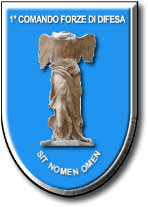
The Italian Army is the land-based component of the Italian Armed Forces of the Italian Republic. The army's history dates back to the unification of Italy in the 1850s and 1860s. The army fought in colonial engagements in China, Libya, Northern Italy against the Austro-Hungarian Empire during World War I, Abyssinia before World War II and in World War II in Albania, Greece, North Africa, Russia and Italy itself. During the Cold War, the army prepared itself to defend against a Warsaw Pact invasion from the east. Since the end of the Cold War, the army has seen extensive peacekeeping service and combat in Afghanistan and Iraq. Its best-known combat vehicles are the Dardo infantry fighting vehicle, the Centauro tank destroyer and the Ariete tank and among its aircraft the Mangusta attack helicopter, recently deployed in UN missions. The headquarters of the Army General Staff are located in Rome, at the back of the Presidential Palace. The army is an all-volunteer force of active-duty personnel.

The Italian Front or Alpine Front was a series of battles at the border between Austria-Hungary and Italy, fought between 1915 and 1918 in World War I. Following the secret promises made by the Allies in the Treaty of London, Italy entered the war in order to annex the Austrian Littoral and northern Dalmatia, and the territories of present-day Trentino and South Tyrol. Although Italy had hoped to gain the territories with a surprise offensive, the front soon bogged down into trench warfare, similar to the Western Front fought in France, but at high altitudes and with very cold winters. Fighting along the front displaced much of the civilian population, of which several thousand died from malnutrition and illness in Italian and Austrian refugee camps. The Allied victory at Vittorio Veneto, the disintegration of Austria-Hungary and the Italian capture of Trento, Bolzano and Trieste ended the military operations.
The Italian Tenth Army was an Italian Army which fought in World War I and in Italian North Africa during World War II.

Viktor Graf von Scheuchenstuel was a Colonel General in the Austro-Hungarian Army. He was a general staff officer and division commander until World War I broke out. During World War I he was a Corps and Army commander serving in Serbia, Albania and Italy. During World War I he was promoted to Graf in the Austrian nobility. Following the end of World War I and the end of the Austro-Hungarian Empire, Scheuchenstuel retired from the military. He died in Vienna.
The Italian Eighth Army was an Italian Army which fought in World War I and on the Eastern Front during World War II.

The Allied leaders of World War I consist of the political and military figures that fought for or supported the Allies during World War I.

Gaetano Giardino was an Italian soldier that rose to the rank of Marshal of Italy during World War I.
The 332nd Infantry Regiment was an infantry regiment of the United States Army, active during World War I. It was part of the 83rd Infantry Division, and served on the Italian front during the war, taking part in the Battle of Vittorio Veneto. It was disbanded in May 1919.

The 14th Army was an army level command of the German Army in World War I formed in September 1917 in Krainburg for use against Italy. Its Headquarters was located at Vittorio Veneto from 10 November 1917 until the army was disbanded on 22 January 1918. The 14th Army served on the Italian Front throughout its existence.

The Vittorio Veneto Armored Brigade was an armored brigade of the Italian Army. Its core units were armored and mechanized cavalry squadrons. The brigade's headquarters was in the city of Villa Opicina, with most of its units based in the Province of Trieste. The brigade's name was chosen to remember the decisive Italian World War I victory at the Battle of Vittorio Veneto.

The 5th Army Corps was one of three corps the Italian Army fielded during the Cold War. Based in the regions of Veneto and Friuli-Venezia-Giulia the corps was the army's main combat force. The 5th Army Corps was arrayed close to the Yugoslavian border and tasked with meeting any Warsaw Pact forces that crossed the border. On the left flank of the corps the 4th Alpine Army Corps was tasked with blocking the Alpine passes and in the rear of the corps the 3rd Army Corps served as operational reserve. After the end of the Cold War the corps was reduced in size and on 1 October 1997 it became the 1st Defence Forces Command. In 2013 the COMFOD 1° was disbanded and its function and brigades taken over by the 20th Infantry Division Friuli in Florence.
See also: 1917 in Italy, other events of 1918, 1919 in Italy.
The Italian 9th Army was a World War I and World War II field army.
The Italian Seventh Army was an Italian Army which was formed in World War I and World War II.
The Italian Sixth Army was an Italian Army which was formed in World War I and World War II.
Giulio Cesare Tassoni was an Italian general. He was the governor of Tripolitania for a few months in 1915.

Luca Montuori was an Italian general during World War I.

The 172nd Siege Battery was a unit of Britain's Royal Garrison Artillery (RGA) raised during World War I. It manned heavy howitzers on the Western Front and Italian Front from 1916 to 1918.













